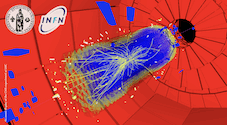Speaker
Dr
Giovanni Marchiori
(LPNHE Paris)
Description
To extend the physics reach of the LHC, upgrades to the accelerator are planned which will increase the peak luminosity by a factor 5 to 10. To cope with the increased occupancy and radiation damage, the ATLAS experiment plans to introduce an all-silicon inner tracker with the HL-LHC upgrade. For radiation damage reasons, only electron-collecting sensors designs are considered (n-in-p and n-in-n).
To investigate the suitability of pixel sensors using the proven planar technology for the upgraded tracker, the ATLAS Planar Pixel Sensor R&D Project was established comprising 17 institutes and more than 80 scientists. Main areas of research are the performance of planar pixel sensors at highest fluences, the exploration of possibilities for cost reduction to enable the instrumentation of large areas, the achievement of slim or active edges to provide low geometric inefficiencies without the need for shingling of modules and the investigation of the operation of highly irradiated sensors at low thresholds to increase the efficiency.
The presentation will give an overview of the recent accomplishments of the R&D project. Among these are laboratory and testbeam results obtained with irradiated FE-I3 and FE-I4 n-in-n pixel detectors and investigations of the edge efficiency of dedicated slim-edge designs.
Author
Dr
Giovanni Marchiori
(LPNHE Paris)

